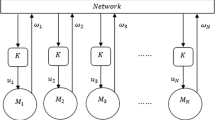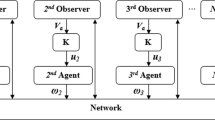Abstract
In this paper, a new agent-based method is proposed to address the speed synchronization problem in the network-connected motors. In this study, DC motor is used, driven by a buck chopper circuit. In the proposed method, the consensus protocol of the leader-following multi-agent system is modified, in order to make consensus on the speed among multiple motors in the network, so that they can attain synchronous speed. In order to have a stable system, a common Lyapunov function is developed such that consensus is said to be reached if the ith agent is controllable and observable. MATLAB is used for the purpose of simulation, and results obtained authorize the proposed methodology.







Similar content being viewed by others
References
Sergaki ES, Stavrakakis GS, Pouliezos AD (2002) Optimal robot speed trajectory by minimization of the actuator motor electromechanical losses. J Intell Robot Syst 33(2):187–207
González I, Salazar S, Torres J, Lozano R, Romero H (2013) Real-time attitude stabilization of a mini-uav quad-rotor using motor speed feedback. J Intell Robot Syst 70(1–4):93–106
Sanchez A, García Carrillo LR, Rondon E, Lozano R, Garcia O (2011) Hovering flight improvement of a quad-rotor mini UAV using brushless DC motors. J Intell Robot Syst 61(1–4):85–101
Nunez C, Alvarez R, Cervantes I (2004) Comparison of multi-motor synchronization techniques. In: Industrial electronics society, 2004. IECON 2004. 30th annual conference of IEEE, vol 2, pp 1670–1675. IEEE
Lee H-H, Jeong U-H (2000) A study on speed synchronization for multi-motors using controller area network. In: Science and technology, 2000. KORUS 2000. Proceedings. The 4th Korea–Russia international symposium on, vol 2, pp 234–239. IEEE
Pérez-Pinal FJ, Nunez C, Alvarez R (2005) Multi-motor synchronization technique applied in traction devices. In: IEEE international conference on electric machines and drives, 2005
Chen S, Zhang K, Zhang W, Shi Z, Liu C, Chen J, Liu T (2010) Design of multi-motor synchronous control system. In: Proceedings of the 29th Chinese control conference, pp 3367–3371. IEEE
Fucai L, Xuelian Z, Liwei L (2002) Synchronous control theory and practical study of multi-motor synchronous driving system. Control Eng China 9:87–90
Ren J, Li C-W, Zhao D-Z (2009) Linearizing control of induction motor based on networked control systems. Int J Autom Comput 6(2):192–197
Zhao D, Zhang S, Li C, Stobart R (2013) Scheduling and control co-design of networked induction motor control systems. In: 2013 IEEE international conference on information and automation (ICIA), pp 880–885
Zhao D, Li C, Ren J (2011) Fuzzy speed control and stability analysis of a networked induction motor system with time delays and packet dropouts. Nonlinear Anal Real World Appl 12(1):273–287
Matsuo K, Miura T, Taniguchi T (2006) Speed control of a dc motor system through delay time variant network. In: 2006 SICE-ICASE international joint conference, pp 399–404. IEEE
Almutairi NB, Chow M-Y, Tipsuwan Y (2001) Network-based controlled DC motor with fuzzy compensation. In: Industrial electronics society, 2001. IECON’01. The 27th annual conference of the IEEE, vol 3, pp 1844–1849. IEEE
Sheikholeslami M, Sheykholeslami FB, Khoshhal S, Mola-Abasia H, Ganji DD, Rokni HB (2014) Effect of magnetic field on Cu–water nanofluid heat transfer using GMDH-type neural network. Neural Comput Appl 25(1):171–178
Sheikholeslami M, Ganji DD (2016) Heat transfer improvement in a double pipe heat exchanger by means of perforated turbulators. Energy Convers Manag 127:112–123
Sheikholeslami M, Ganji DD (2016) Heat transfer enhancement in an air to water heat exchanger with discontinuous helical turbulators; experimental and numerical studies. Energy 116:341–352
Olfati-Saber R, Fax A, Murray RM (2007) Consensus and cooperation in networked multi-agent systems. Proc IEEE 95(1):215–233
Wang C, Ji H (2014) Leader-following consensus of multi-agent systems under directed communication topology via distributed adaptive nonlinear protocol. Syst Control Lett 70:23–29
Hu J, Hong Y (2007) Leader-following coordination of multi-agent systems with coupling time delays. Phys A Stat Mech Appl 374(2):853–863
Xie T, Liao X, Li H (2016) Leader-following consensus in second-order multi-agent systems with input time delay: an event-triggered sampling approach. Neurocomputing 177:130–135
Djaidja S, Wu QH (2015) Stochastic consensus of leader-following multi-agent systems under additive measurement noises and time-delays. Eur J Control 23:55–61
Hu A-H, Hu M, Guo L (2014) Consensus of a leader-following multi-agent system with negative weights and noises. IET Control Theory Appl 8(2):114–119
Hong Y, Hu J, Gao L (2006) Tracking control for multi-agent consensus with an active leader and variable topology. Automatica 42(7):1177–1182
Hu J, Feng G (2010) Distributed tracking control of leader–follower multi-agent systems under noisy measurement. Automatica 46(8):1382–1387
Godsil C, Royle GF (2013) Algebraic graph theory, vol 207. Springer Science & Business Media, New York
Li Z, Duan Z (2014) ”Cooperative control of multi-agent systems: a consensus region approach” Automation and Control Engineering. CRC Press, Boca Raton
Mesbahi M, Egerstedt M (2010) Graph theoretic methods in multiagent networks. Princeton University Press, Princeton
Peng K, Yang Y (2009) Leader-following consensus problem with a varying-velocity leader and time-varying delays. Physica A 388:193–208
Horn RA, Johnson CR (2012) Matrix analysis. Cambridge University Press, Cambridge
Xu W, Ho DWC, Li L, Cao J (2015) Leader-following consensus of general linear multi-agent systems: event-triggered schemes. In: Control conference (ASCC), 2015 10th Asian, pp 1–6. IEEE
Acknowledgements
This work is supported by National Natural Science Foundation of China under Grant 61273114, the Innovation Program of Shanghai Municipal Education Commission under Grant 14ZZ087, the Pujiang Talent Plan of Shanghai City China under Grant 14PJ1403800, the International Corporation Project of Shanghai Science and Technology Commission under Grants 14510722500, 15220710400.
Author information
Authors and Affiliations
Corresponding author
Ethics declarations
Conflict of interest
The authors declare no conflict of interest.
Rights and permissions
About this article
Cite this article
Masroor, S., Peng, C. Agent-based consensus on speed in the network-coupled DC motors. Neural Comput & Applic 30, 1647–1656 (2018). https://doi.org/10.1007/s00521-016-2773-y
Received:
Accepted:
Published:
Issue Date:
DOI: https://doi.org/10.1007/s00521-016-2773-y




